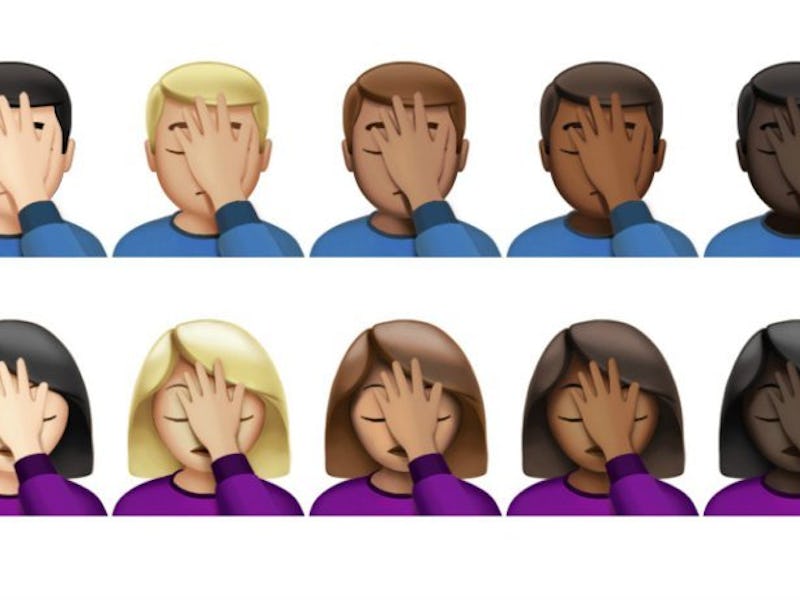The Facepalm Goes Back Thousands of Years
It's been going on since time immemorial.

This week, Apple introduced its first facepalm emoji, ceding to the pleas of exasperated texters who for years had to design their own, inevitably janky workarounds. At a time when there is more reason than ever before to cup your sad face in your own trembling hands, Apple is finally giving the people a way to quickly communicate their own frustration and misery.
The ancient symbol, which roughly translates to “not again with this shit,” has finally joined a pantheon of digital expressions that includes dancing ladies and that weird handwritten “100.” And even though the term “facepalm” was only formally introduced into Macmillan Dictionary in 2006, the sentiment is a tale as old as time.
Let’s start around 113 A.D., with an ancient Roman artwork called “Trajan’s Column.” Here is the soldier. Things aren’t going as planned, the battle is lost, and so the enduring comfort of a face resting in a hand provides temporary respite in a moment of difficulty. In this case, it’s far more likely that the column was intended to express sadness rather than frustration, as the facepalm is currently associated with.
A similar expression is seen in Henri Vidal’s 1896 statue “Cain,” depicting the man immediately after killing his brother, cradling his head in his hand. Again, this is a way of communicating regret and the state of being upset, usually as a result of one’s own actions. Because we use the image now as a meme for anything that comes out of Donald Trump’s mouth, it is clear that the sentiment of the facepalm has evolved since its introduction in famous artworks.
Lexicographer Susie Dent suggested that the facepalm endures through history because of how it can be used in a variety of ways: an expression of sadness, frustration, or avoidance.
“One of the reasons I think it is so successful — and this is always a key indicator of linguistic survival or success — is that the phrase can move about in different ways and you can can put it into different parts of speech,” she told the Guardian in 2001.
The facepalm is found as a common communication technique in the animal kingdom, as well. In the case of mandrill monkeys, an individual covers their face using their palm as a way to express a desire to be left alone and avoid the social life of a larger group. The concept of hiding from others for a socially motivated reason is yet another application of the same physical movement, and could be seen as an interpretation of any facepalm; whatever you’re feeling, you’re covering your face to avoid and hide from the feeling being provoked by the circumstance.
Then, there’s the modern interpretation that spawned the emoji you’ll be using after every episode of American Horror Story this season: the “Only Sane Man,” “I’m Surrounded By Idiots” interpretation.
The pop culture usage of the facepalm tends to take on a slightly different meaning than the mandrills. Perhaps the most famous example of the facepalm in television is Jean-Luc Picard in Star Trek: The Next Generation, who hides his handsome Patrick Stewart face in his hands whenever his crew members are found to be incompetent, frustrating, or otherwise lacking. Originating in the late ‘80s, this is one of the earliest examples of the contemporary interpretation of the expression. The other universally recognized example is Homer Simpson’s calling card since The Simpsons debuted in 1989, the slap of a forehead accompanied with a “D’oh!” This in particular is communicating raw frustration, where the gentle regret or self-loathing found in pieces like “Cain” are completely absent.
The facepalm evolved yet again during the Great Recession and other contemporary financial crises, where the image of a stock broker with his head in his hands became the universal symbol of “we fucked up fam.” There were many pictures of Wall Street executives with the stressed out resignation at another dip in the market that entire websites were devoted to the phenomenon. These expressions hearken back to the early facepalms of regret, which seems to a prevailing natural use of the motion, while in popular culture tends to be a more aggressive statement on someone else’s actions rather than one’s own.
Perhaps the closest match to Apple’s facepalm emoji is the accompaniment of a healthy “SMH” (shaking my head, for rubes not in the know). This shorthand phrase emerged in the early 2010s and has since been inducted into the Oxford dictionary. It is defined there as being “used to express disapproval, exasperation, frustration.” This is far closer to the Jean-Luc Picard usage than the stockbrokers and mandrills cradling their heads in their hands, and is the likely usage for the emoji.
The iconic Picard facepalm.
No matter whether you’re using it as a noun, verb, or adjective, or as an expression of exasperation, anger, social avoidance, or a good old-fashioned SMH, you’ll be able to facepalm into oblivion in any gender or race of your choosing with the new Apple emoji. If current events are any indication, we’ll be needing it.